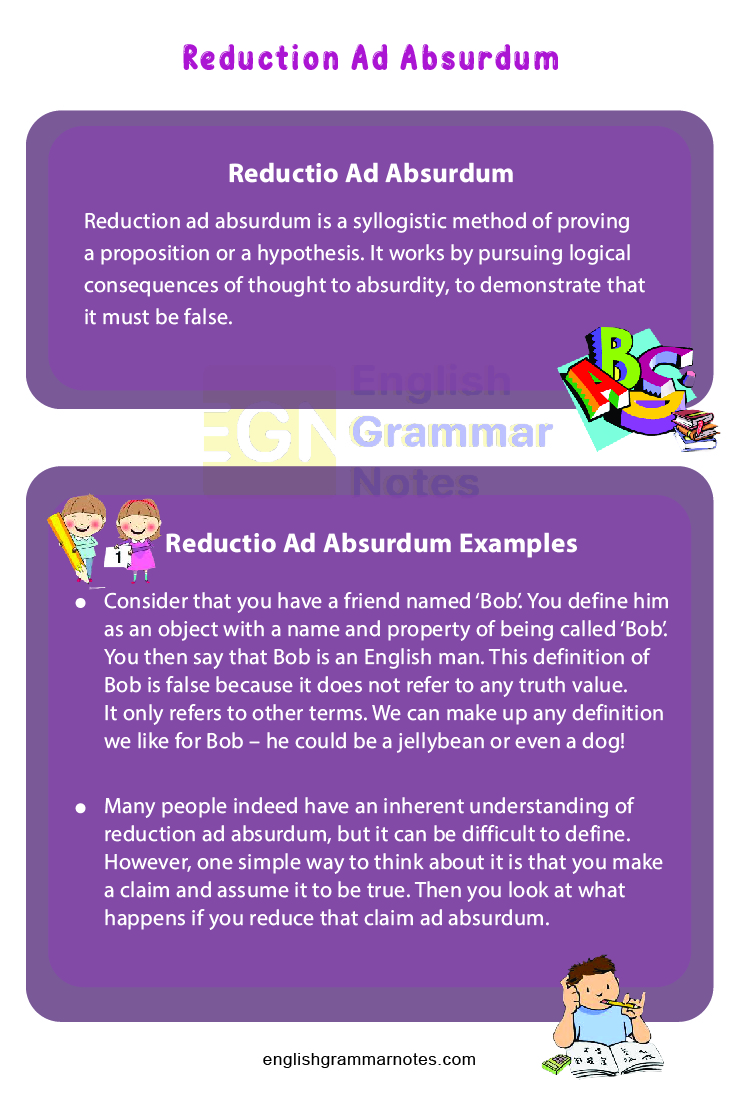You might know the phrase reduction ad absurdum as reducing to absurdity, which means disproving an argument by pushing it to its logical conclusion. It’s usually used in logic, mathematics, and philosophy when you need to poke holes in someone else’s argument.
For example, if someone said that all rich people are greedy, you could refute that statement by pointing out that Bill Gates and Warren Buffett are both billionaires who give plenty of their money away through charitable causes. Here are some more examples of reduction ad absurdum in action, including two examples from classic literature.
- Reductio Ad Absurdum – Definition & Meaning
- Reductio Ad Absurdum Examples
- Greek Philosophy of Reduction Ad Absurdum
- Principle of Non-Contradiction
- What is reduction ad absurdum?
- What are the three steps in a reduction ad absurdum?
- Is reduction ad absurdum a valid argument?
- Who took the ideas of reduction absurdum?
Reductio Ad Absurdum – Definition & Meaning
Reduction ad absurdum is a syllogistic method of proving a proposition or a hypothesis. It works by pursuing logical consequences of thought to absurdity, to demonstrate that it must be false.
- A good example of reduction ad absurdum: A person says I am never wrong. The reductionist might respond with If you are never wrong, you must know everything; so how come you don’t know what day it is?
- The reductionist has reduced his opponent’s statement from a universal claim (which would have been impossible for him to prove) to a particular one (knowing what day it is), which he can then refute.
- In English learning, we usually use Reduction Ad Absurdum as an exercise to practice our English skills.
- For example: Say you want to learn some new words in English, but you are afraid that if you learn them they will go out of your head quickly like yesterday’s news.
- So instead of simply learning them and forgetting them right away, we use Reduction ad absurdum as an exercise.
Reductio Ad Absurdum Examples
You cannot reduce an infinite number of sentences to an infinite amount of meaning. You can only reduce it to nothing. We now see that all these concepts are meaningless (or false, if you like). They are not truths at all, but rather mere words with no truth value.
Reduction ad absurdum shows that definitions do not refer to meanings; they refer to other terms. Definitions tell us what things and properties belong to a concept in a sentence. Examples of Reduction Ad Absurdum are as follows:-
- Consider that you have a friend named ‘Bob’. You define him as an object with a name and property of being called ‘Bob’. You then say that Bob is an English man. This definition of Bob is false because it does not refer to any truth value. It only refers to other terms. We can make up any definition we like for Bob – he could be a jellybean or even a dog!
- Many people indeed have an inherent understanding of reduction ad absurdum, but it can be difficult to define. However, one simple way to think about it is that you make a claim and assume it to be true. Then you look at what happens if you reduce that claim ad absurdum.
- A claim reduced ad absurdum leads to a contradiction. Examples: * 1+1=2 is true, but 1+1=4 is false. * The statement, Socrates is human can be reduced ad absurdum by asking if Socrates has all human properties and if Socrates doesn’t have all human properties.
- We can reduce The moon is made of cheese to absurdity by pointing out that if it were true, then we would all be able to go there and eat it. Since we cannot do so, we know that The moon is made of cheese is false. (By saying If A then B and showing that B does not follow from A, you are proving that A itself must be false.
- Reduction ad absurdum shows that a statement is meaningless or false because it leads to a contradiction when reduced ad absurdum. It can also show that a statement is meaningless or false because it leads to an obvious falsehood when reduced ad absurdum.
Check out other logical fallacies as well by referring to the page available and study about them.

Greek Philosophy of Reduction Ad Absurdum
Reduction ad absurdum is a form of argument that attempts to show that a given claim is false by showing that its acceptance leads to an absurd conclusion.
This can be used to prove or disprove mathematical conjectures and logical arguments by repeatedly applying reduction ad absurdum in an attempt to derive a contradiction.
We can also use Reduction Ad Absurdum in different fields like philosophy, ethics, politics, economics, science, etc.
- For example, Aristotle used it to argue that sophistical refutations were incorrect. Similarly, Socrates used it as a critical method. It is widely used in mathematics. Plato and his student Aristotle often used Reduction Ad Absurdum to develop concepts like Platonism and Aristotelianism.
- There are also various other examples of reduction ad absurdum in other fields where an absurdity arises because of its acceptance by the majority. You will find Reduction Ad Absurdum throughout literature, politics, science and more!
Principle of Non-Contradiction
This ancient and elegant principle is perhaps best explained by Aristotle. In his Metaphysics, he writes: It is impossible that the same thing should at once belong and not belong to the same subject and in respect of the same thing.
Simply put, for a statement to be true, it cannot contradict itself; an object or idea cannot both exist and not exist simultaneously. This means that a statement like It is raining outside, and it is not raining outside cannot be true. The reason why is rather obvious: if one were to look out a window, they would either see rain falling or they wouldn’t. No other scenario is possible in our universe.
If it is raining, then what you are saying (it isn’t) can’t be true; if it isn’t raining, then what you are saying (it is) can’t be true. We can apply reduction ad absurdum to statements of all kinds—even statements about God!
See More:
FAQs on Reduction Ad Absurdum
1. What is reduction ad absurdum?
It is a form of argument that gets us from a false premise to an absurd conclusion by logic.
2. What are the three steps in a reduction ad absurdum?
- The first step in a reduction ad absurdum is to identify an assumption or premise.
- The second step is to show that if we assume that premise to be true
- In the third step, we will end up with an absurd conclusion.
3. Is reduction ad absurdum a valid argument?
As we have seen, reduction ad absurdum can lead to a false conclusion if used improperly.
4. Who took the ideas of reduction absurdum?
In Greek, reduction ad absurdum means reduction to absurdity.
Conclusion
The result of reduction ad absurdum is that nothing becomes an element of any and every theory. In reality, we have nothing in one term, but we have nothing. The fact that it is self-contradictory doesn’t matter to reduction ad absurdum: if you try to prove something using a self-contradictory argument, you will succeed! But your statement cannot be true. Reduction ad absurdum assumes that each step in reasoning is necessary; if one step can be removed without invalidating everything else, then all steps can be removed and there won’t be anything left at all!
